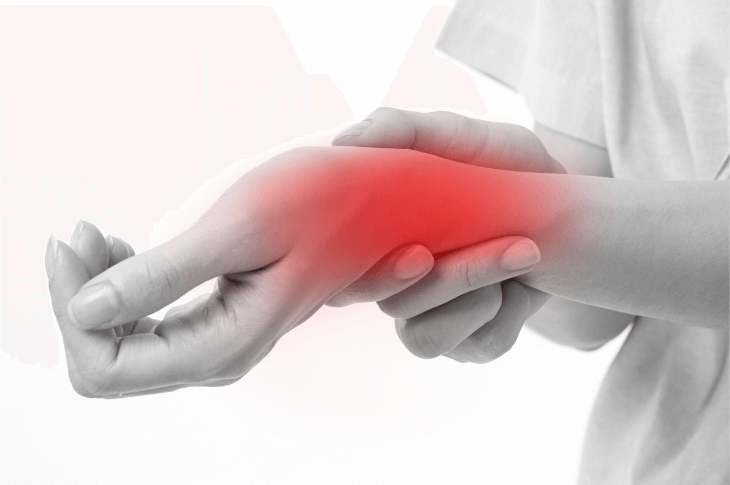
Arthritis is a painful condition that comes in various forms. It causes inflammation and pain that can make completing daily tasks difficult. This condition is very common and there is currently no cure for it. A wider understanding of arthritis and the differences between its types can help remove the stigma and cultivate support for those living with the condition.
What is Arthritis?
There are numerous types of arthritis, all of which cause inflammation and pain in the joints. In fact, there are over 100 different variations of arthritis, some of which are very common. The two most common types of arthritis are osteoarthritis and rheumatoid arthritis.
Osteoarthritis (OA)
Osteoarthritis is the most common type of arthritis. Around nine million people in the UK are affected by this condition. Anyone can develop osteoarthritis, but it’s most common in people over the age of 40, and is more frequently diagnosed in women than men. A family history of osteoarthritis also puts people at a higher risk. However, it can occur at any age, including during childhood. It may stem from an injury or other related conditions, or it may develop on its own. It most commonly impacts joints in the hands, hips, knees, and spine.
When osteoarthritis first begins to develop, it damages the joint’s cartilage lining. This is what can cause the initial pain and difficulty with certain movements. The continuous damage to the cartilage lining puts excess pressure on other tissues, such as ligaments and tendons. At this point, in addition to pain and stiffness, people may begin to notice swelling of the affected joint. If the damage to the cartilage becomes severe, the bones may begin to rub against one another. This can then cause the bones to become deformed which forces them to move from their original position. Some people also develop osteophytes, which are a type of bone spur.
Rheumatoid arthritis (RA)
Rheumatoid arthritis is less common than osteoarthritis, but it still impacts a considerable number of people. In the UK, over 400,000 people have this autoimmune disorder. The most common age bracket for the development of rheumatoid arthritis is between 40 and 50, although it can occur at any age. Both men and women can develop RA, but the chances of a woman developing it are three times higher than that of a man.
When rheumatoid arthritis develops, it means the immune system is targeting certain joints. In particular, the outer layer of the joint is the first part to become damaged. This part of the joint is known as the synovium. At this point, people will feel pain and may notice swelling in the affected joint. Once this spreads to the rest of the joint, the swelling may increase in severity. People with this condition also experience the shape of their joints changing, which can lead to further damage. This damage may include the breakdown of bone structures and cartilage. As rheumatoid arthritis is an autoimmune condition, it can also cause issues in other parts of the body.

Other types of arthritis
Some other types of arthritis include gout, secondary arthritis, reactive arthritis, psoriatic arthritis, and enteropathic arthritis.
- Gout typically impacts the feet, especially the big toe, although it can occur in other parts of the body. It’s caused by a build up of uric acid and causes severe arthritis symptoms.
- Secondary arthritis is the name given to arthritis that develops following an injury.
- Reactive arthritis causes issues in the joints as well as other tissues such as the eyes and the urethra, typically occurring following an infection.
- Psoriatic arthritis is a condition that impacts the joints of people with psoriasis.
- Enteropathic arthritis occurs in around one in five people with some form of irritable bowel disease and typically impacts joints in the spine and limbs.
Arthritis causes, symptoms, and treatments
The causes, symptoms, and treatments of arthritis vary depending on the type and severity of the condition.
Causes
The cause of arthritis can vary from person to person. Some common factors that may contribute to its development can include:
- Obesity
- Damage from joint overuse
- Injury
- Being over the age of 45
- Genetics
- Autoimmune conditions
- Weakened muscles
- Being a woman
Symptoms
The main symptoms of arthritis are often similar across the different variations of the condition. These include:
- Joint pain
- Joint swelling
- Joint stiffness
Additional symptoms of rheumatoid arthritis may include:
- Stiffness in the morning
- Numerous affected joints
- It’s common for people with RA to have symptoms in the same joint on each side.
- Tiredness
- Inflammation in other areas of the body
- This may include the mouth, heart muscles, eyes, and blood vessels.
- A diminished amount of red blood cells
- Fever
Additional symptoms of osteoarthritis may include:
- Redness of the affected joint
- Reduced range of motion
- Cracking or popping sound from the joint when bent
- Bony growths (particularly in the fingers)
- Weakened muscles in the surrounding area
- Joint buckling
- The sensation of scraping (particularly in the knee joints)
Treatments
There is no cure for arthritis, so those who develop it can expect to live with it for the rest of their lives. However, there are many lifestyle changes and treatment options that can lessen the severity of its symptoms. These include:
- An arthritis-safe exercise regimen
- Various types of medications that relieve symptoms like pain and inflammation
- The best type of medication depends on what works for each individual.
- There are medications designed specifically to reduce the progression and symptoms of rheumatoid arthritis that would not be used for someone with osteoarthritis.
- Physical and/or occupational therapy
- If necessary, weight loss to reduce pressure on the affected joints
- A diet rich in nutrients and vitamins
- Cold and hot compresses
- Surgery
Debunking arthritis misconceptions
Despite arthritis being a relatively common condition, there are still key points that many people misunderstand about it. For example, some people believe that there’s little to no difference between the varying types of arthritis, which is completely false. Between the two most common types alone there are numerous important differences, including the fact that RA is an autoimmune disorder and OA is a musculoskeletal condition.
Another common misconception is that arthritis can only occur in adults, specifically over the age of 40. However, not only can arthritis be diagnosed in younger adults, it can also occur in children. Most of the various types of arthritis that impact children fall under the umbrella term ‘juvenile idiopathic arthritis'. There are around 15,000 cases across the UK. The cause is largely unknown, but symptoms can improve with age and growth. Proper nutrition and maintaining a healthy weight are crucial for achieving this.
Some people also believe that those with arthritis can’t or shouldn’t exercise. This is entirely untrue. In fact, aside from medications, exercise is considered one of the most effective and important treatments for arthritis. This is because it can help with mobility while strengthening the muscles that support the affected joints. It’s important for people with arthritis to carefully construct their exercise regimen to ensure they partake in activities that are both safe and beneficial.
Raising awareness of arthritis
Arthritis is a condition that impacts millions of people across the world, yet many people still don’t fully understand it or how they can help. Those who want to raise awareness of arthritis can participate in international awareness campaigns like World Arthritis Day, which occurs on the 12th of October every year. This falls within the UK’s National Arthritis Week, which runs from the 7th until the 13th of October.
Participating in these events may include sharing information on social media, wearing a blue ribbon, or donating funds to a relevant charity. Those who have personal connections with people who live with arthritis can offer their support in more tactile ways. This may include helping them complete tasks that are difficult on days when their symptoms are more severe.
Arthritis support groups
Arthritis support groups offer a way for people living with similar conditions and symptoms to come together. This network of support can provide valuable resources, advice, and companionship for people with all types of arthritis. It can be hard for those who don’t have the condition to relate to or fully understand those who do. Talking to people who share similar experiences can help those with arthritis feel less alone and more supported. Support groups can be attended in person or online.
Versus Arthritis offers a directory of support groups across the UK. Simply entering a postcode reveals a list of nearby meetings. For those with rheumatoid arthritis, National Rheumatoid Arthritis Society also offers a directory of local support groups across the country. The NHS offers their own support group where people with arthritis can enjoy speakers, raffles, tea, and bring and buy stalls.
For those who prefer a virtual setting, there are many arthritis support groups on social media, particularly on Facebook. Osteoarthritis (OA) Support UK Only offers a 12K-strong community of people with osteoarthritis from across the country who come together to share experiences and advice. As osteoarthritis is more common in women, there are women-focused support groups for the condition, such as Osteoarthritis Women, which also has 12K members.
There are also dedicated support groups for rheumatoid arthritis on social media, such as Rheumatoid Arthritis in the UK, which has over 16K members, and Rheumatoid Arthritis Group, which has over 74K members. More general groups for multiple types of arthritis are also available, such as Arthritis Support Group, which is a smaller scale group with 1.2K members.
As there is no cure for any form of arthritis, sharing stories, experiences, and advice can be the key to finding the best treatment options available. This can help people reduce their symptoms and improve their overall quality of life.










